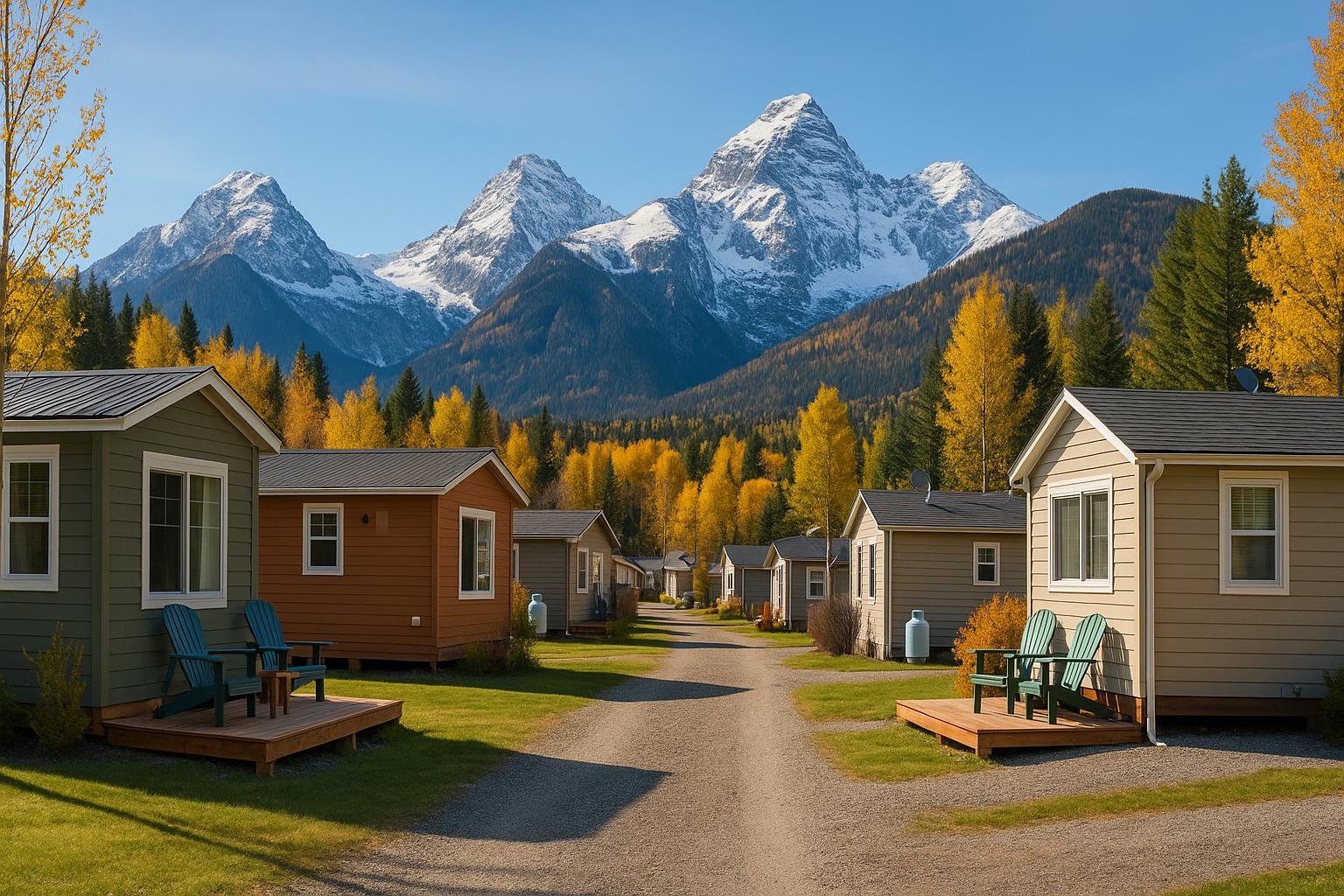
Snowbird Tiny Home Communities: The 2025 Guide to Flexible, Affordable Seasonal Living in Canada
Estimated reading time: 8 minutes
Key Takeaways
- Innovative Living: Snowbird tiny home communities provide a flexible, affordable, and compact living solution designed for seasonal residents in Canada.
- Community Driven: These communities focus on shared facilities, social events, and group activities for enhanced mental and physical wellbeing.
- Legal and Practical Focus: With evolving zoning laws and building codes, residents can enjoy a worry-free lifestyle backed by municipal support.
- Forward-Thinking Design: Emphasis on modular construction, energy efficiency, and smart home integrations makes these homes ready for the future.
Table of contents
- Introduction to Snowbird Tiny Home Communities
- What Are Snowbird Tiny Home Communities?
- Benefits of Seasonal Living in Tiny Home Villages
- Logistics and Practicalities for Canadian Snowbirds
- Flexible Housing 2025: Innovations and Trends
- Retirement Living and Lifestyle Advantages
- How to Get Started
- Conclusion
- Frequently Asked Questions
Introduction to Snowbird Tiny Home Communities
Snowbird tiny home communities are a fast-growing trend among Canadian seasonal residents and retirees who crave a cost-effective and flexible way to spend the winter months. These compact, community-driven spaces—known as snowbird tiny homes—are purpose-built for seasonal living in Canada and are shaping the future of flexible housing 2025 and retirement living.
So, what exactly are snowbird tiny home communities? They’re carefully designed, compact dwellings grouped into vibrant villages, meant for Canadians who want affordable, flexible, communal places to live during the winter or other seasons. With rising property costs, increased insurance premiums, currency challenges, and ongoing changes at the Canada–U.S. border, more and more snowbirds are shifting their gaze away from traditional southern U.S. properties and exploring domestic solutions. New research shows that these communities offer not just affordability but also support, flexibility, and a thriving social environment. For more details, check out the perspectives from Kelowna Real Estate and Discover South Florida.
What Are Snowbird Tiny Home Communities?
Defining Snowbird Tiny Home Communities and Tiny Home Villages
- Snowbird tiny homes: Typically under 400 square feet, yet fully equipped with energy-efficient appliances, full bathrooms, and cozy living spaces tailored for seasonal residents and retirees. More on this at OutBuilders.
- Tiny home villages: Communities that group these compact homes around shared amenities like communal gardens, clubhouses, and walking trails to foster social engagement.
Why Tiny Home Villages Stand Out:
- Community Integration: These layouts promote social relationships through regular gatherings, wellness workshops, and community-based activities.
- Shared Facilities: Expect central laundries, hobby rooms, fitness centres, and even a shared tool library.
- Active Seasonal Living: Unlike traditional retirement homes, these vibrant communities emphasize maintaining an active and social lifestyle.
For an in-depth look at tiny home living benefits and lifestyle rewards, visit our guide on tiny home living benefits.
Benefits of Seasonal Living in Tiny Home Villages
Why Retirees and Snowbirds Are Choosing Tiny Home Villages
Affordability
- Lower Costs: Tiny homes are much more affordable to buy and maintain compared to traditional seasonal properties.
- Predictable Expenses: By staying domestic, residents avoid rising insurance premiums and currency fluctuations, as noted by Kelowna Real Estate.
Flexibility and Customization
- Modular Options: Customizable layouts let residents choose designs that reflect personal tastes, whether for a minimal retreat or a well-appointed space.
- Custom Features: Options for upgrades such as skylights, decks, solar panels, and storage sheds tailored for seasonal needs, as seen with OutBuilders.
Maintenance and Mobility
- Less Upkeep: With their smaller footprint, tiny homes require less cleaning and fewer repairs.
- Mobility: Some designs are even moveable, allowing snowbirds to relocate as desired.
Enhanced Social Opportunities
- Community Spaces: Shared lounges, kitchens, and hobby areas simplify staying connected.
- Active Social Calendar: Regular events such as classes, communal dinners, and hobby clubs help reduce isolation.
For those interested in affordable, sustainable, and stylish compact living, our guide on tiny home living delves into modular and eco-friendly design options.
Logistics and Practicalities for Canadian Snowbirds
Navigating Legal and Lifestyle Details for Seasonal Living in Canada
Legal and Zoning Considerations
- Municipal Support Varies: Some regions are adapting zoning laws to welcome tiny home villages, while others maintain restrictions regarding minimal dwelling sizes or seasonal occupancy.
- Building Codes: Adhering to local building and safety codes is essential to avoid complications later on.
- Advocacy and Change: Increased demand is prompting municipalities to consider fresh bylaws for flexible housing, as highlighted by OutBuilders.
Property Management
- Onsite Teams & Maintenance: Many communities have dedicated teams for landscaping, snow clearing, and repairs, supported by resident committees.
- Shared Resources: Tools, gardening equipment, and community vehicles are often available for collective use.
Climate Adaptability
- Year-Round Comfort: With features like enhanced insulation and triple-pane windows, these homes are designed to handle harsh Canadian winters.
- Green Energy: Solar panels, energy-efficient lighting, and modern HVAC systems are quickly becoming standard, as showcased at the Tiny Home Show Ontario 2025 by OutBuilders.
Amenities and Services
- On-Site Facilities: Community-based facilities such as laundry, workout studios, libraries, and hobby shops enhance daily living.
- Medical and Support Services: Many communities offer wellness checks, visiting nurses, or community shuttles for appointments and errands.
Understanding the tiny home legal requirements is fundamental. Visit our guide on tiny home legal requirements Canada for a detailed rundown of building codes and zoning rules.
Flexible Housing 2025: Innovations and Trends
What’s Next for Flexible Housing and Retirement Living?
Modular Housing Innovations
- Prefab Construction: Modular and prefabricated designs allow for rapid assembly and offer residents the flexibility to customize their layouts.
- Sustainable Materials: The shift towards recycled metals and renewable resources like bamboo flooring is marking a new trend in tiny home construction.
Technology Integration
- Smart Homes: Features such as automated lighting, climate control, and remote monitoring are making tiny homes safer and more convenient.
- Sustainable Features: Integration of solar panels, greywater recycling, and EV charging stations are becoming increasingly popular. Read more about these innovations in our articles on energy efficiency in tiny homes and tiny home automation in Canada.
Growth in Retirement Living
- Expanding Options: Developers are now creating new snowbird villages that meet the needs of active, independent seniors.
- Connected Communities: Digital tools and apps are linking residents, making community management and social scheduling easier than ever.
The flexible housing revolution is rapidly evolving, positioning tiny home communities as a leading solution for tomorrow’s retirement living.
Retirement Living and Lifestyle Advantages
How Tiny Home Villages Improve Life for Canadian Retirees
Social and Health Benefits
- Active Lifestyles: With on-site fitness classes, walking groups, yoga sessions, and cycling clubs, staying active is effortless.
- Reduced Isolation: Regular communal meals and social events significantly diminish feelings of loneliness.
- Mental Wellness: Participation in group activities helps maintain mental health and fosters a deep sense of belonging.
Financial Advantages
- Lower Entry Costs: Compared to seasonal condos or cross-border properties, tiny homes represent a much more economical investment.
- Minimal Upkeep: Their smaller size ensures fewer maintenance demands and overall lower living expenses.
- Shared Resources: Bulk purchasing and community-shared amenities help further reduce individual costs.
Community Programs
- Workshops and Classes: Residents enjoy art, gardening, and woodworking classes that stimulate creativity and build community bonds.
- Social Events: Regular potlucks, movie nights, and themed dinners enliven community living.
- Support Networks: Organized wellness checks and mutual aid initiatives ensure that no one feels left out.
Discover more about the beneficial impacts on mental health and wellbeing by reading our post on tiny homes mental health Canada.
How to Get Started
First Steps for Canadians Interested in Snowbird Tiny Homes and Seasonal Living
- Evaluate Local Zoning and Legal Requirements:
- Research municipal bylaws and stay updated as many regions are introducing pilot projects for tiny homes.
- Attend Relevant Events:
- Visit events like the Tiny Home Show Ontario 2025 to tour homes, meet builders, and gather ideas from current residents. More info available at OutBuilders.
- Connect with Builders and Associations:
- Choose reputable builders who understand Canadian codes and can offer tailored customizations. Join online forums and groups for insights.
- Explore Additional Resources:
- Consult local government documents, retirement living directories, and online communities to gather comprehensive information.
- Plan for 2025 and Beyond:
- Budget for upfront costs, ongoing fees, and even moving expenses, while prioritizing features such as mobility, amenities, and privacy.
For detailed tips on selecting the right professional, check out our guide: How to Choose a Reliable Tiny Home Builder Canada.
Conclusion: Why Snowbird Tiny Home Communities Are the Future
Snowbird tiny home communities offer Canadian seasonal residents and retirees a modern, affordable, and flexible pathway to retirement living. With compact, energy-efficient tiny homes and well-planned villages that emphasize community, these solutions address rising costs, shifting regulations, and the desire for a vibrant social life.
This innovative approach is driven by economic realities and progressive trends in housing. As flexible housing continues to evolve in 2025, these communities stand as a smart, sustainable, and welcoming choice for a forward-thinking lifestyle.
Frequently Asked Questions
Q1: What exactly is a snowbird tiny home community?
A: It’s a compact, community-driven living environment specifically designed for Canadians looking for seasonal or retirement living solutions. These communities focus on affordability, flexibility, and shared amenities.
Q2: Are these tiny homes built to withstand harsh Canadian winters?
A: Yes, modern snowbird tiny homes incorporate enhanced insulation, triple-pane windows, and adaptable HVAC systems to manage even the coldest weather.
Q3: Can residents customize their tiny home layout?
A: Absolutely. Many developers offer modular and customizable options to cater to personal tastes and specific lifestyle needs.
Q4: Where can I learn more about the legal requirements for tiny homes in Canada?
A: For detailed information on zoning, building codes, and other legalities, please visit our comprehensive guide on tiny home legal requirements Canada.

Leave a Reply